Fall Container Garden Vegetables
Inside: Even if you don’t have a lot of space, you can grow a fall vegetable garden in containers. Learn what vegetables you can grow in a fall garden and when to plant them.
The gardening season doesn’t have to end when the summer crops are done. With a little planning, a fall garden can be a great way to extend the season.
And fall is the perfect time to start a container vegetable garden. With fewer bugs to contend with and cooler weather, growing fall container garden vegetables can be very enjoyable.
And I actually find growing a fall garden in containers to be easier than trying to grow a garden in my regular beds. You can get the seeds to germinate easier in the shade (since it’ll be hot when you start) and later move the plants to the sun when they need it.
It’s also easier to water a few containers near the house than to drag a hose out to the garden. But if you want to grow some vegetables this fall, you need to start planning for them sooner than you think.
Affiliate Disclosure: Please note that some of the links in this article may be affiliate links and I may receive a small commission if you purchase something through a link. It will not change your cost. As an Amazon Associate, I earn from qualifying purchases. For more information, see my disclosures page.)
Planning for a Fall Vegetable Garden
While some things like lettuce and radishes don’t take long to mature, other crops like broccoli, cauliflower, and Brussels sprouts need much longer. And most vegetables will require even more time than stated on the seed packet when planted in the fall.
As the number of daylight hours wanes, the plants grow slower. I always like to allow an additional 10 days to 2 weeks for any fall-grown vegetables.
If you’ve got containers of summer vegetables that are spent, go ahead and pull them out to make room for fall planting. Depending on where you live, some crops should be started as early as late July for a fall harvest.
I explain how to determine when to start your fall vegetables below. But if you want a printout of the information, you can get my FREE Quick-Start Guide to Growing a Fall Garden sent straight to your inbox.
What Vegetables to Grow in a Fall Container Garden
If you’ve never grown a fall garden before, the first vegetable I recommend you try for fall containers is lettuce. It is easy to grow from seed and will reward you with many salads for several months.
Lettuce can handle a light frost so you can oftentimes harvest lettuce even after your summer crops of tomatoes and peppers are just a memory.
But you shouldn’t just stop at lettuce. There are so many other fall garden vegetables that can easily be grown in containers. Carrots, radishes, beets, spinach, kale, rutabagas, and turnips all tend to grow better in cooler weather.
These are easy for beginners to grow and all these can be directly sown in your containers from an inexpensive packet of seed.
If you want to try broccoli, cauliflower, cabbage, or Brussels sprouts, you need to start them indoors or purchase transplants. If you plan to start your own seeds, you definitely need to purchase a grow light. It is almost impossible to produce healthy transplants without one.
Read How to Start Vegetable Seeds for more information.
The hardest part about starting a fall vegetable container garden is keeping the containers watered during the heat of the summer when you need to start your fall garden vegetables.
One way to make watering easier is to use self-watering containers. However, even with a self-watering container, you may still need to water the container from the top by hand once or twice a day until the seeds germinate.
Keeping the seed moist is critical to soften the seed coating and allow it to sprout. For some vegetables, it may be easier to purchase transplants at your local garden center.
However, root crops such as beets, carrots, and radishes need to be sown directly in the container they will grow in so just purchase seeds for those vegetables.
Carrots can be the trickiest of all the root vegetables to get to germinate. But I’ve recently learned this trick for getting carrot seeds to germinate.
If you don’t mind watering, my favorite containers to grow vegetables in are grow bags. I have a fairly large garden, and I still love to grow a few things in grow bags.
My carrots are always larger and my lettuce tends to grow faster in grow bags. I prefer the 10-gallon size as I can still move them myself, but they are large enough to grow several different vegetables in the fall. And they are large enough to hold a tomato plant in the summer so I can use them in both seasons.
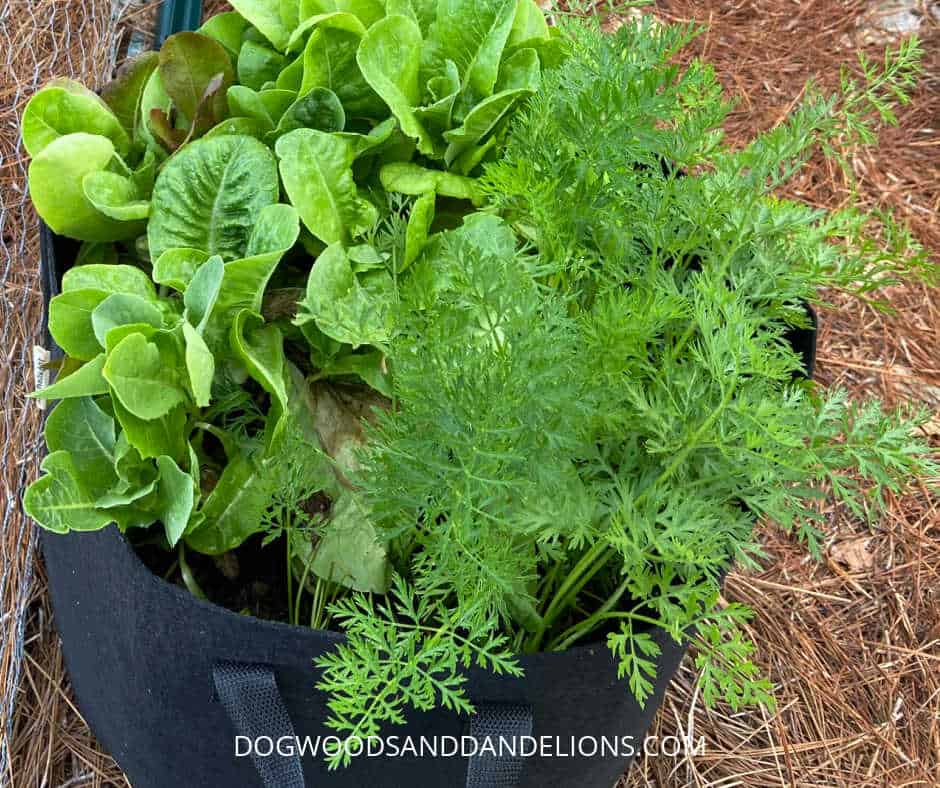
Fall Container Garden Vegetables
The list below shows the large variety of vegetables that you can grow in a fall container garden.
- Asian greens
- beets
- broccoli
- brussels sprouts
- cabbage
- carrots
- cauliflower
- chard
- Chinese cabbage
- cilantro
- claytonia (miner’s lettuce)
- garlic
- greens such as mustard and collard
- kale
- kohlrabi
- lettuce
- mache
- parsley
- peas
- radish
- rutabagas
- spinach
- Swiss chard
- turnips
Since I also like to make my garden both productive as well as beautiful, I love tucking a few flowers among my vegetables. Pansies, mums, and verbena will last well into the fall in most climates.
And for some interesting texture and color, heuchera (coral bells) is a great accent plant in the fall container vegetable garden.
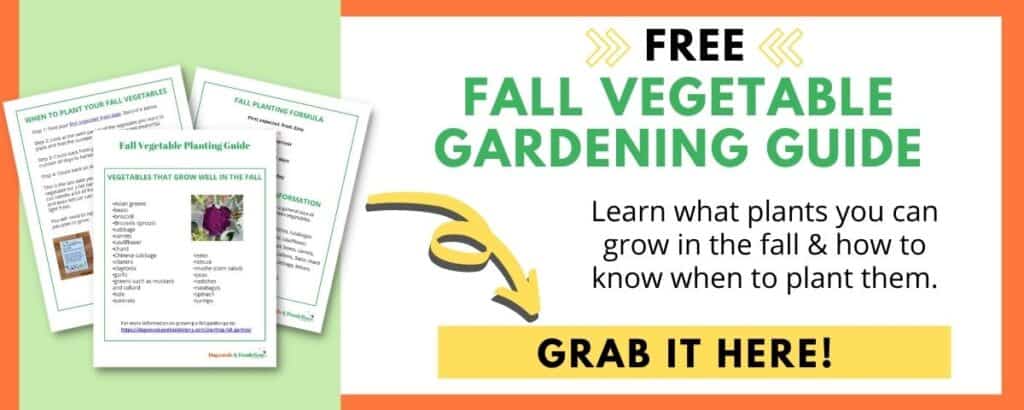
When to Plant Your Fall Container Garden
Finding information about when to plant your fall container garden is not something that’s easy to locate. It seems there is some secret cult to keeping this information from the general public.
The first year I tried growing vegetables in the fall, I started almost everything too late.
So that you don’t make the same mistake I made, I’m going to share my method for knowing when to start your fall vegetables. This easy method has served me well over the years.
Find Your Frost Date
First, find your first expected frost date. This easy tool lets you plug in your zip code and it will tell you when you can expect your first frost in the fall.
Keep in mind, this is an estimate based on years of prior data. Mother Nature often has other plans.
Find How Long it Takes to Harvest Your Vegetables
Second, look at your seed packet and find the days to harvest. It is usually located somewhere on the back of the seed packet. (It is actually on the front in the packet below.)
Once you find that date, count backwards from your first expected frost date that number of days. Continue counting back an additional 10 – 14 days to allow for the vegetables to grow slower due to cooler weather and shorter amounts of daylight. That day is the last possible planting day for that vegetable.
You will need to do this with each vegetable you plan to grow. Keep in mind, you can plant your seeds a bit earlier or stagger plantings to harvest your veggies over a longer time frame.
Would you like the fall growing formula in a printable format? Get it here in my Free Quick-Start Guide to Growing a Fall Garden. The guide also includes a list of fall vegetables and a chart to record your specific planting dates.
And a few of these winter hardy vegetables will survive some light frosts so you can keep harvesting those even longer.
I have even had a few vegetables survive the winter in my zone 7 garden. I’ve had kale, Swiss chard, and carrots all survive until spring.
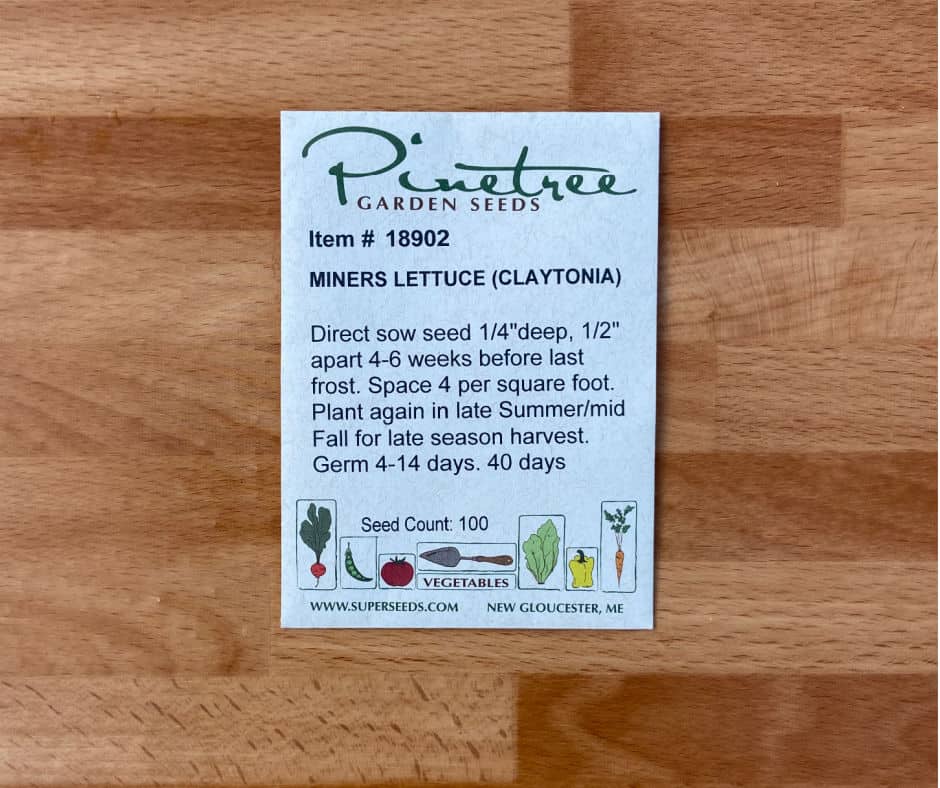
The Fall Planting Formula in Action
Let’s use an example to illustrate how the fall planting formula works. We are going to use a packet of miner’s lettuce as an example.
My last frost date in zip code 28032 is October 31. This seed packet actually gives you quite a bit of useful information. It says it takes 40 days to harvest.
So I want to count backwards 40 days from October 31. That’s September 22. I also need to count back an additional 10-14 days to allow for slower growth in the fall. That now puts me at September 12 to plant this packet of miner’s lettuce. That’s the last day I should plant if I want to harvest the vegetables before frost.
When to Plant Your Fall Vegetables
The list below will give you an idea of when you can plant various vegetables in the fall.
- 12-14 weeks – parsnips, peas, radishes, rutabagas
- 10-12 weeks – Set out transplants of broccoli, cauliflower, Brussels sprouts, and cabbage. Start from seed: beets, carrots, celery, collards, kale, leeks, lettuce, radishes, scallions, Swiss chard
- 8-10 weeks – arugula, Asian greens, Chinese cabbage, lettuce, mustard, spinach, turnips
- 6-8 weeks – lettuce, mache (corn salad), spinach
- 2 weeks – garlic, onions
So truly, the hardest part of growing a fall vegetable garden is getting it started before it’s too late. If you start it on time and keep it watered, you will be surprised at the amount of food you can grow in a few containers on your porch or deck.
A Few Container Garden “Recipes”
To make it easy for you to know what to plant, I like to provide a few container garden “recipes” – collections of vegetables, herbs, and flowers you can plant together in the same pot. Here are a few of my favorites.
- lettuce, carrots, and radishes
- kale, carrots, and mache
- pansies, Swiss chard, and carrots
If the planting dates are different for the vegetables you want to combine in one planter, start all the seeds according to the earliest planting date for fall. Planting some of your fall vegetables a bit early is okay.
-Have you ever grown a fall vegetable garden before? What would you like to grow?
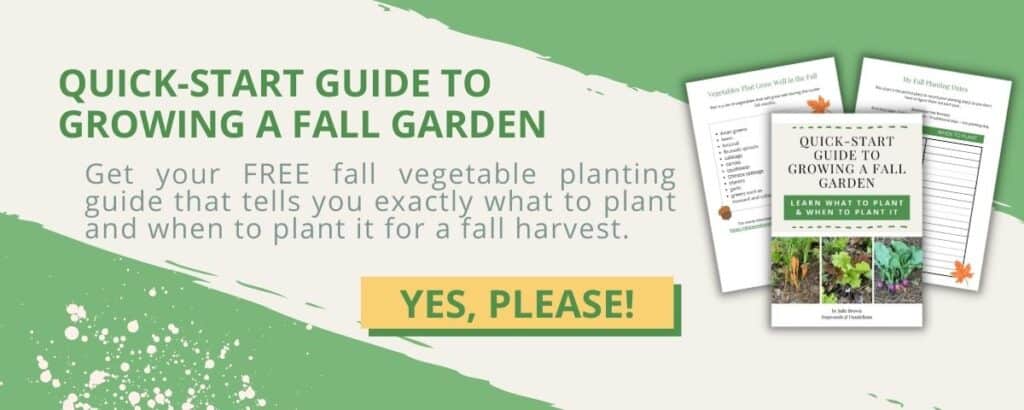
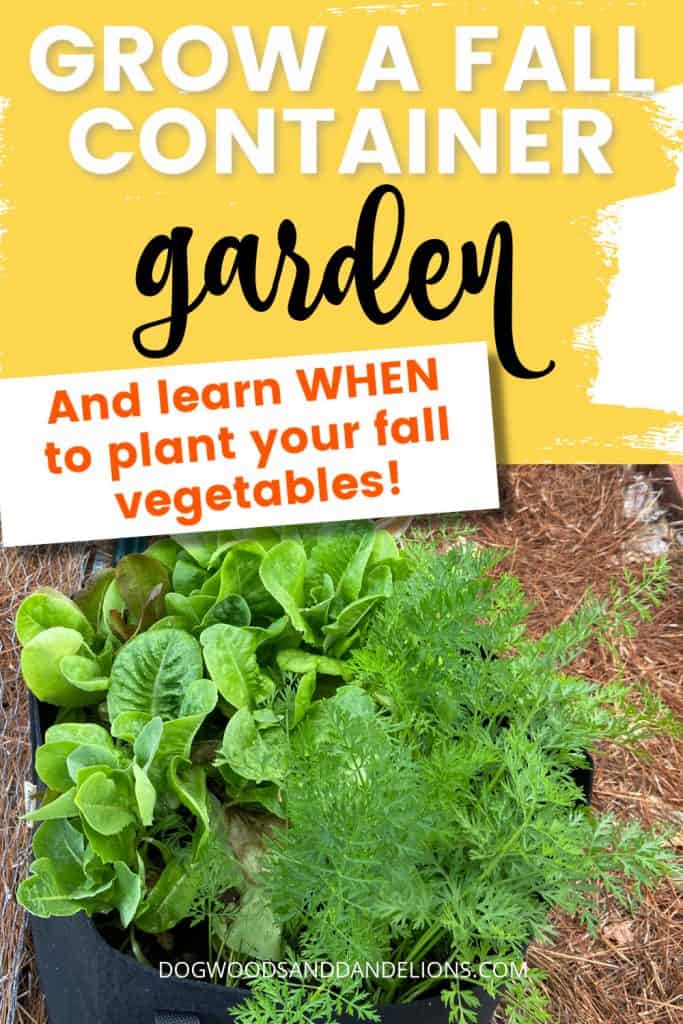

Great article. Thanks
You’re very welcome. I’m glad you found it helpful.